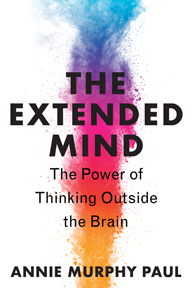- Home
- Articles
- Reviews
- About
- Archives
- Past Issues
- The eLearn Blog
Archives
| To leave a comment you must sign in. Please log in or create an ACM Account. Forgot your username or password? |
|
Create an ACM Account |

Early hypotheses about where thinking occurred in the body included placing the mind in the heart. More advanced investigations revealed that it’s our brain that is the locus of thinking. Scientific studies, from behavioral to cognitive, have reinforced this view. In fact, you are liable to believe that, indeed, our brain is our thinking organ. Yet an increasing suite of research is suggesting our thinking is not just locked in our head. Annie Murphy Paul, in The Extended Mind: The Power of Thinking Outside the Brain, brings in research to explore ways in which thinking extends beyond our skin.
I’ve been a fan of work on distributed cognition (e.g. Ed Hutchins’ Cognition in the Wild) and social cognition (e.g. Vygotsky and Bandura), even referencing them in my own latest book. Where I have a chapter, however, Ms. Paul has written an entire book, and adds another topic: embodied cognition. As a journalist, her take is illustrated with stories and examples, making it accessible. Overall, The Extended Mind breaks out cognition into three areas: embodied cognition, distributed cognition, and social cognition (though she terms them bodies, surroundings, and relationships).
After an introduction, each of the three sections looks at three different areas. The first section focuses on using our body to think. The first chapter covers interoception, the signals we receive from our body about our body. We get signals from different organs and joints that clue us into situations that we have to comprehend, and the evidence is that we would be wise to listen (at least in areas where we’ve developed some experience). The next chapter looks at bodily movement. Translating thinking to motion, such as turning our bodies into the agents we’re trying to understand, increases our understanding. In the final chapter of this section, we explore how gesture externalizes our thinking in useful ways. For instance, our gestures actually precede our words, helping shape our thinking.
Insights continue in the second section on space. The first chapter in this section covers the benefits of nature for calming us and fostering creativity. How we design spaces for thinking is a subsequent chapter, and here research illuminates, for instance, how open-plan designs are flawed from a thinking perspective. The third chapter in this section looks at how externalizing thinking into concrete artifacts allows us to discuss them and refine them. The goal is to use our spatial reasoning abilities, e.g. navigation, to help us comprehend new material.
The third section looks at relationships. The first chapter here is on how to work with experts, including the importance of modeling and copying behavior. The next chapter looks at the value of group discussion to foster understanding. The third chapter looks at how we can and should work in groups. This includes the benefits of coordinating our thinking, and ritual.
The author makes an important point in her introduction:
“Our efforts at education and training, as well as management and leadership, are aimed almost exclusively at promoting brainbound thinking…Meanwhile, there is no corresponding cultivation of our ability to think outside the brain”
That blind spot, about disregarding elements that aren’t explicitly tied to internal cognition, is an important contribution of the book. When we can look more broadly, we get a richer picture of thinking, and learning.
This may seem challenging in the context of eLearning: How do we deal with bodies and space in a virtual environment? The social is possible, but how about motion and gesture? Yet there are clear implications here for offloading thinking onto external representations, asking people to move, and encouraging them to balance time outside with time inside (and online). For one, the recommendations to have a personalized space for working and learning provide a unique consideration for the choice of learning environments.
As a long-term advocate of distributed and social cognition, I think it’s valuable to have an accessible, well-illustrated discussion of topics that are frequently too esoteric for many learning experience designers. Personally, the addition of embodied cognition was a wonderful learning opportunity. This book is an important contribution to our recursive reflection on our own thinking and consequently for how we design for optimal outcomes. Highly recommended.
Clark Quinn leads learning system design through Quinnovation, providing strategic solutions to Fortune 500, education, government, and not-for-profit organizations. He earned his Ph.D. in applied cognitive science from the University of California, San Diego, and has led the design of mobile, performance support, serious games, online learning, and adaptive learning systems. He's an internationally known speaker and author, with five books and numerous articles and chapters. He has held management positions at Knowledge Universe Interactive Studio, Open Net, and Access CMC, and academic positions at the University of New South Wales, the University of Pittsburgh's Learning Research and Development Center, and San Diego State University's Center for Research in Mathematics and Science Education.
Permission to make digital or hard copies of all or part of this work for personal or classroom use is granted without fee provided that copies are not made or distributed for profit or commercial advantage and that copies bear this notice and the full citation on the first page. Copyrights for components of this work owned by others than ACM must be honored. Abstracting with credit is permitted. To copy otherwise, or republish, to post on servers or to redistribute to lists, requires prior specific permission and/or a fee. Request permissions from [email protected].
© ACM 2021 1535-394X/2021/07-3473603 $15.00
|
To leave a comment you must sign in. |
|
Create an ACM Account. |